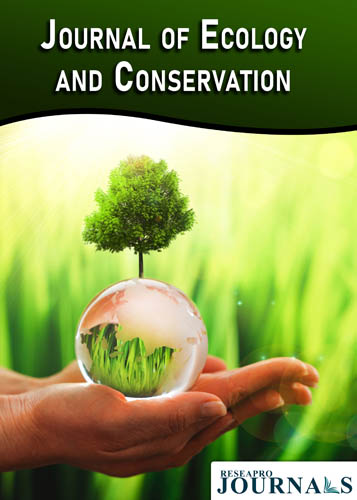
Journal of Ecology and Conservation
OPEN ACCESS
ISSN: 3048-5177

OPEN ACCESS
ISSN: 3048-5177

1Bioenergy Lab (BDTC), School of Biotechnology, Campus-11, KIIT Deemed-to-be University, Odisha, India
2College of Agriculture, Central Agricultural University, Manipur, India
3Department of Biotechnology, GIT, GITAM Deemed-to-be University, Visakhapatnam, India
4Chemical Engineering Department, Jadavpur University, Kolkata, India
5Department of Chemistry, Government College of Engineering, Keonjhar, Odisha, India
6Molecular Diagnostic Laboratory, Johns Hopkins Aramco Healthcare, Dhahran, Saudi Arabia
7College of Medicine, Alfaisal University, Riyadh, Saudi Arabia
8Department of Public Health and Nutrition, University of Haripur, Haripur, Pakistan
9School of Biotechnology, KIIT Deemed-to-be University, Odisha, India
Numerous naturally available biological products including the metabolites are synthesised that have valuable and significant applications in numerous important sectors integrated in to human life. Biologically-sourced enzymes from plants, animals and microbes are capable of degrading complex biological polysaccharides like cellulose, hemicellulose, lignin, pectin etc. Hemicellulose is an important plant cell wall component synthsised through pentose/hexose pathways. The pentose sugars, the monomeric form of it, could further be transformed to valuable metabolites like clean energy, organic acids, alcohols, single-cell protein and pigments, as also useful enzymes. Clostridium stercorarium, for instance, contains 50 dedicated genes to produce thermostable hemicellulose-degrading enzymes like glycoside hydrolase. Arabinoxylooligosaccharides degrading GH10 xylanases, xylanases Xyn105F and β-D-xylosidase Bxl31D are also reported. While Phanerochaete chrysosporium possesses cellobiohydrolase, filamentous fungi like Aspergillus and Trichoderma reportedly can degrade hemicellulose. This review attempts at detailed insights into the natural sources of hemicellulose, its extraction approaches and the responsible hemicellulose-degrading bioenzymes. Their numerous applications in various sectors is also discussed.
Received 01 April 2024; Revised 22 April 2024; Accepted 02 May 2024
1Bioenergy Lab (BDTC), School of Biotechnology, Campus-11, KIIT Deemed-to-be University, Odisha, India
2College of Agriculture, Central Agricultural University, Manipur, India
3Department of Biotechnology, GIT, GITAM Deemed-to-be University, Visakhapatnam, India
4Chemical Engineering Department, Jadavpur University, Kolkata, India
5Department of Chemistry, Government College of Engineering, Keonjhar, Odisha, India
6Molecular Diagnostic Laboratory, Johns Hopkins Aramco Healthcare, Dhahran, Saudi Arabia
7College of Medicine, Alfaisal University, Riyadh, Saudi Arabia
8Department of Public Health and Nutrition, University of Haripur, Haripur, Pakistan
9School of Biotechnology, KIIT Deemed-to-be University, Odisha, India